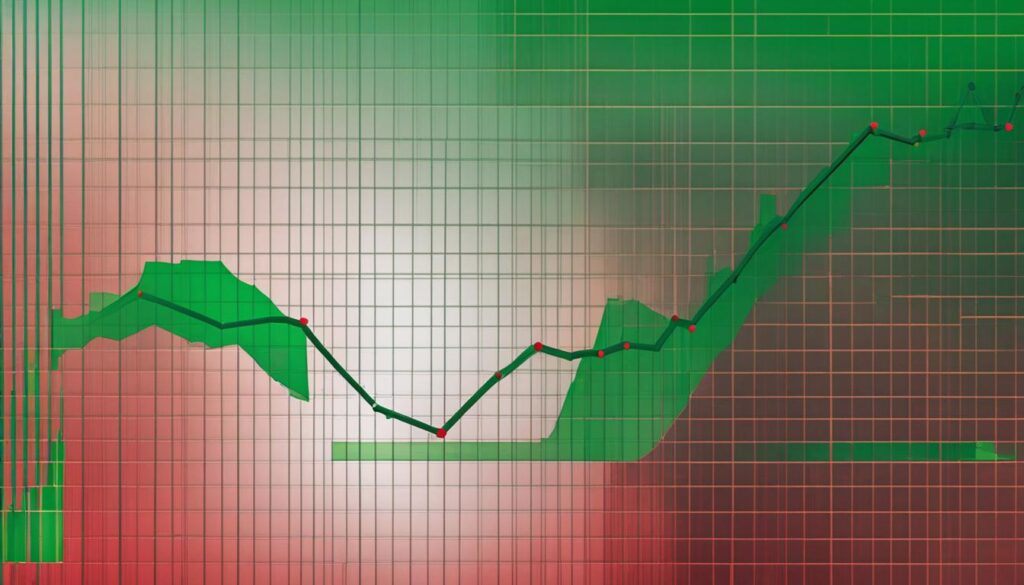As a beginner in the world of forex trading, understanding the latest trends is crucial for success in this dynamic market. The forex or FX market is a global platform where currencies are exchanged, and it offers significant opportunities for traders of all sizes. In this article, I will explore the key trends that beginners should be aware of to make informed trading decisions.
Key Takeaways:
- Forex trading is the exchange of currencies in the global marketplace.
- It operates 24/5 and involves trading electronically over the counter.
- Forex trends can be identified through price chart analysis and technical indicators.
- Trend trading strategies, such as trendline breakouts and triangles, can be effective for beginners.
- Remember to conduct thorough research and practice risk management when trading forex.
What is the Forex Market?
The forex market is a decentralized marketplace for trading currencies worldwide. Unlike traditional financial markets, there is no central exchange for forex trading. Instead, it operates electronically over the counter (OTC), allowing participants to trade currencies directly with one another. This market is open 24 hours a day, five and a half days a week, enabling trading activities across major financial centers worldwide.
Currencies are traded as exchange rate pairs, such as EUR/USD for the euro against the U.S. dollar. The forex market consists of two primary segments:
- The spot market: In the spot market, currencies are bought and sold for immediate delivery, based on their current market price. It is the most common and accessible form of forex trading for retail investors and traders.
- The derivatives market: The derivatives market offers a range of financial instruments, including forwards, futures, options, and currency swaps. These allow market participants to hedge against currency fluctuations and speculate on future currency price movements.
Market participants in the forex market include institutions, investment banks, commercial banks, and retail investors. It is a highly liquid market with significant trading volumes, making it attractive to a wide range of participants seeking opportunities in currency trading.
How Does the Forex Market Work?
The forex market operates as a continuous, nonstop trading market. In the past, it was dominated by institutional firms and large banks, but it has become more retail-oriented in recent years, with traders and investors of all sizes participating. The forex market does not have physical trading venues; it consists of connected trading terminals and computer networks.
Currency trading was difficult for individual investors until it became accessible online. Commercial and investment banks still conduct most of the trading in forex markets, but there are opportunities for professional and individual investors to trade currencies against each other. The market offers various trading instruments, including spot, forwards, futures, and options contracts.
“The forex market has evolved over time, welcoming retail investors and providing them with opportunities to engage in currency trading. With advancements in technology, individual traders can now participate in the forex market, which was once exclusive to institutional firms and banks.” – Forex Expert
| Trading Instruments | Description |
|---|---|
| Spot Contracts | Immediate exchange of currencies at the current market price. |
| Forwards Contracts | Agreements to trade currencies at a future date and predetermined exchange rate. |
| Futures Contracts | Standardized contracts to buy or sell currencies at a future date and preset price. |
| Options Contracts | Contracts that give the holder the right, but not the obligation, to buy or sell currencies at a future date and predetermined price. |
Individual investors can now engage in forex trading alongside institutional players, leveraging trading platforms and online resources to analyze the market, execute trades, and manage their portfolios. This increased accessibility has opened doors for retail investors, allowing them to take advantage of the potential benefits and opportunities offered by the forex market.
How to Identify Forex Trends
Trend identification is crucial in forex trading. As a trader, I visually inspect price charts to identify trends based on consecutive higher tops and higher bottoms, indicating an uptrend. Conversely, consecutive lower tops and lower bottoms indicate a downtrend. While visual analysis is valuable, I also rely on technical indicators to enhance my trend identification process.
Moving averages are one of the most commonly used technical indicators in forex trading. They help me identify the average price of a currency pair over a specific period and determine the trend based on price levels relative to the moving average line. When the price is consistently above the moving average, it suggests an uptrend, whereas a price below the moving average suggests a downtrend.
MACD (Moving Average Convergence Divergence) is another powerful technical indicator I utilize in trend identification. It measures the difference between two exponential moving averages and displays the results as a line graph. When the MACD line crosses the equilibrium line, it signals a potential trend reversal, presenting an opportunity to enter or exit a trade.
Momentum indicators also play a significant role in my trend identification strategy. Momentum measures the rate of price change and provides signals for uptrends or downtrends based on the position relative to the equilibrium line. By analyzing momentum, I can identify the strength and direction of a trend, enabling me to make more informed trading decisions.
Trend Identification Tools:
- Visual analysis of price charts
- Moving averages
- MACD
- Momentum indicators
By incorporating these trend identification techniques and leveraging technical indicators such as moving averages, MACD, and momentum, I can effectively identify and capitalize on forex trends. This allows me to make informed trading decisions and enhance my overall trading strategy.
Top Trend Trading Strategies in Forex
When it comes to forex trading, there are several popular trend trading strategies that traders can employ to maximize their chances of success. These strategies are designed to capitalize on the momentum of market trends and provide entry points for profitable trades. In this section, I will discuss four of the most effective trend trading strategies in forex.
Trendline Breakout Strategy
The trendline breakout strategy involves identifying key trendlines on a price chart and waiting for a breakout above or below these lines. When the price breaks above a downward trendline or below an upward trendline, it signals a potential shift in the market’s direction. Traders can then enter the market in the direction of the breakout, anticipating further price movement in that direction.
Triangles Strategy
Triangles, such as ascending and descending triangles, are powerful chart patterns that indicate strong momentum in the market. An ascending triangle forms when the price reaches higher lows while encountering resistance at a horizontal trendline. On the other hand, a descending triangle occurs when the price creates lower highs while finding support at a horizontal trendline. Traders can enter long or short positions when the price breaks out of the triangle pattern, fully capitalizing on the momentum.
Counter-Trend Trading Strategy
Counter-trend trading strategies involve predicting trend reversals and taking trades opposite to the prevailing trend. This strategy requires careful analysis of price charts and key indicators to identify potential reversal points. When a counter-trend trader spots a potential reversal, they enter orders that go against the current trend, aiming to profit from the ensuing price correction.
Catch a Wave Strategy
The catch a wave strategy utilizes moving averages to determine the overall market trend and identifies impulse and corrective waves for trading opportunities. Traders using this strategy aim to enter the market during the beginning of an impulse wave, which is characterized by strong momentum in the direction of the trend. They ride these waves until a corrective wave occurs, allowing them to secure profits and plan their next moves.
By incorporating these trend trading strategies into their forex trading arsenal, traders can increase their chances of catching profitable trends and maximizing their returns. It’s important to remember that no strategy is foolproof, and proper risk management is crucial in forex trading.
| Strategy | Description |
|---|---|
| Trendline Breakout | Identify breakout points above or below trendlines for entry |
| Triangles | Utilize ascending and descending triangle patterns for trend confirmation |
| Counter-Trend Trading | Predict trend reversals and take trades opposite to the prevailing trend |
| Catch a Wave | Use moving averages to identify impulse and corrective waves for trading |
Conclusion
As a beginner in forex trading, understanding and identifying trends is crucial for navigating the market successfully. By utilizing tools like moving averages, MACD, and momentum, I can determine the prevailing direction of the market. These indicators provide valuable insights into market trends, helping me make informed trading decisions.
Implementing trend trading strategies, such as trendline breakouts and triangle formations, can be advantageous for beginners. These strategies offer entry points for capturing opportunities in the market and maximizing potential profits. By following these strategies, I can align my trades with the prevailing trends and increase my chances of success.
However, it is important to remember that forex trading involves risks. As a beginner, I must always conduct thorough research and practice good risk management. This includes setting stop-loss orders, managing leverage, and diversifying my portfolio. With the right knowledge, strategies, and risk management practices, I can navigate the future of forex trading with confidence and work towards achieving my financial goals.
FAQ
What is the foreign exchange market?
The foreign exchange market, also known as forex or FX, is a global marketplace for exchanging national currencies. It is the largest and most liquid asset market in the world, with a daily global volume of $7.5 trillion in 2022, according to a report from the Bank for International Settlements.
How does the forex market work?
The forex market operates as a continuous, nonstop trading market. It lacks a central marketplace and is instead conducted electronically over the counter (OTC). The market is open 24 hours a day, five and a half days a week, and is active across major financial centers worldwide. Currencies are traded as exchange rate pairs, such as EUR/USD for the euro against the U.S. dollar.
Who participates in the forex market?
Market participants include institutions, investment banks, commercial banks, and retail investors. In the past, the market was dominated by institutional firms and large banks, but it has become more retail-oriented in recent years, with traders and investors of all sizes participating.
How can I identify trends in forex trading?
Traders can visually inspect price charts to identify trends based on consecutive higher tops and higher bottoms indicating an uptrend, or consecutive lower tops and lower bottoms indicating a downtrend. Another method is to use technical indicators like moving averages, MACD, and momentum.
What are some popular trend trading strategies in forex?
There are several popular trend trading strategies in forex. These include the trendline breakout strategy, triangles strategies (such as ascending and descending triangles), counter-trend trading strategies, and the catch a wave strategy using moving averages to identify market trends and trading opportunities.
Source Links
- https://www.investopedia.com/articles/forex/11/why-trade-forex.asp
- https://www.forextime.com/education/forex-tutorials/identifying-trends-a-beginners-guide
- https://blueberrymarkets.com/learn/intermediate/trading-trends-in-forex/
Disclaimer
All information on this website is of a general nature. The information is not adapted to conditions that are specific to your person or entity. The information provided can not be considered as personal, professional or legal advice or investment advice to the user.
This website and all information is intended for educational purposes only and does not give financial advice. Signal Mastermind Signals is not a service to provide legal and financial advice; any information provided here is only the personal opinion of the author (not advice or financial advice in any sense, and in the sense of any act, ordinance or law of any country) and must not be used for financial activities. Signal Mastermind Signals does not offer, operate or provide financial, brokerage, commercial or investment services and is not a financial advisor. Rather, Signal Mastermind Signals is an educational site and a platform for exchanging Forex information. Whenever information is disclosed, whether express or implied, about profit or revenue, it is not a guarantee. No method or trading system ensures that it will generate a profit, so always remember that trade can lead to a loss. Trading responsibility, whether resulting in profits or losses, is yours and you must agree not to hold Signal Mastermind Signals or other information providers that are responsible in any way whatsoever. The use of the system means that the user accepts Disclaimer and Terms of Use.
Signal Mastermind Signals is not represented as a registered investment consultant or brokerage dealer nor offers to buy or sell any of the financial instruments mentioned in the service offered.
While Signal Mastermind Signals believes that the content provided is accurate, there are no explicit or implied warranties of accuracy. The information provided is believed to be reliable; Signal Mastermind Signals does not guarantee the accuracy or completeness of the information provided. Third parties refer to Signal Mastermind Signals to provide technology and information if a third party fails, and then there is a risk that the information may be delayed or not delivered at all.
All information and comments contained on this website, including but not limited to, opinions, analyzes, news, prices, research, and general, do not constitute investment advice or an invitation to buy or sell any type of instrument. Signal Mastermind Signals assumes no responsibility for any loss or damage that may result, directly or indirectly, from the use or dependence on such information.
All information contained on this web site is a personal opinion or belief of the author. None of these data is a recommendation or financial advice in any sense, also within the meaning of any commercial act or law. Writers, publishers and affiliates of Signal Mastermind Signals are not responsible for your trading in any way.
The information and opinions contained in the site are provided for information only and for educational reasons, should never be considered as direct or indirect advice to open a trading account and / or invest money in Forex trading with any Forex company . Signal Mastermind Signals assumes no responsibility for any decisions taken by the user to create a merchant account with any of the brokers listed on this website. Anyone who decides to set up a trading account or use the services, free of charge or paid, to any of the Broker companies mentioned on this website, bears full responsibility for their actions.
Any institution that offers a service and is listed on this website, including forex brokers, financial companies and other institutions, is present only for informational purposes. All ratings, ratings, banners, reviews, or other information found for any of the above-mentioned institutions are provided in a strictly objective manner and according to the best possible reflection of the materials on the official website of the company.
Forex/CFD trading is potentially high risk and may not be suitable for all investors. The high level of leverage can work both for and against traders. Before each Forex/CFD investment, you should carefully consider your goals, past experience and risk level. The opinions and data contained on this site should not be considered as suggestions or advice for the sale or purchase of currency or other instruments. Past results do not show or guarantee future results.
Neither Signal Mastermind Signals nor its affiliates ensure the accuracy of the content provided on this Site. You explicitly agree that viewing, visiting or using this website is at your own risk.




